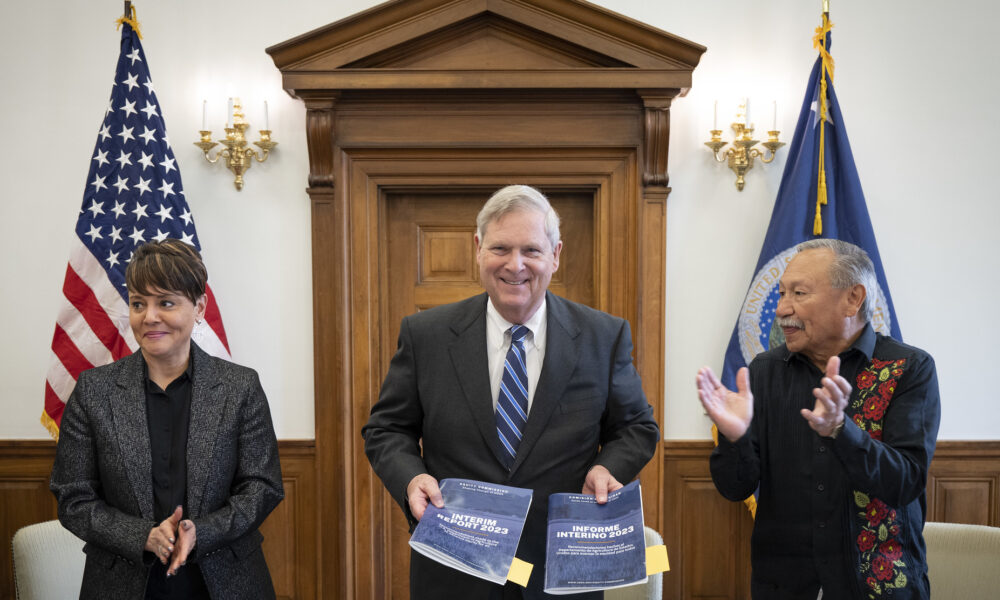On February 28, an advisory committee to the United States Department of Agriculture (USDA) presented Secretary of Agriculture Tom Vilsack with its interim recommendations on how the department should address its long history of programmatic inequity and injustice. The recommendations are sweeping—they span across USDA programs and address the services the department provides to farmers, farmworkers, and consumers, while also tackling institutional issues within the department itself and its support for food and agricultural research. But are they enough?
Having been dubbed “the last plantation” in the 1990s for advancing policies benefiting White farmers and ranchers and large corporations at the expense of BIPOC (Black, Indigenous, and other people of color) farmers, the USDA has a lot of injustice to repair. Over the past 100 years, the number of Black farmers in this country fell from nearly 1 million to less than 50,000, and despite two high-profile lawsuits that were settled in 1999 and 2010, we just learned that Black farmers still were not granted USDA loans at the same rates as other farmers. The USDA also oversees a food system that prioritizes commodities over food crops, benefits industrial agricultural operations that subject farmworkers to health and safety hazards including food insecurity, and offers nutritional assistance that does not actually allow for nutritious (or sustainable) meals. So, we can all agree—including Secretary Vilsack—that there is work to do.
The independent experts from across the food and agriculture sector who comprised the Equity Commission assembled by the Biden administration in 2022 were charged with identifying issues of equity and justice and providing recommendations to correct them. I see three threads tying the commission’s interim recommendations together that, if implemented fully, would be a step in the right direction.
1. Lowering barriers, removing hazards, and promoting equitable participation in programs
The Equity Commission’s first insight is the most obvious: in response to the systemic barriers that hinder access to specific programs, whether it is funding for BIPOC farmers or nutrition programs for BIPOC communities, the commission offers specific recommendations for making USDA programs more equitable. Another set of recommendations addresses the historic hazards farmworkers face and limited access to funding for minority-serving institutions. Changes to programs vary in approaches, including additional funding or targeted funding, technical assistance and support services, redefining program eligibility, rethinking the customer experience, eliminating language barriers, and consistent outreach.
Notable programs for farmers include addressing access to land, including help resolving heirs’ property issues for landowners, funding for climate resilience and conservation for BIPOC farmers, creating new markets, and providing technical assistance to organizations that serve BIPOC farmers, women farmers, and new and beginning farmers. According to my colleague Dr. Omanjana Goswami, “For too long, the USDA’s policies have favored large-scale farming that wreaks havoc on the environment while systemically excluding farmers with small and medium-size operations who implement climate-smart conservation practices on their farms. It is important to ensure that these recommendations are implemented, and the USDA’s actions do not reinforce the status quo. Future funding should be easily accessible and distributed equitably among BIPOC and other underserved farmers who have been historically excluded.”
For farmworkers, the Equity Commission recommends providing more funding, for instance to community-based organizations that promote farmworkers’ access to resources and that address health and safety hazards, including adverse labor conditions related to climate change. Due to immigration and labor laws, farmworkers are the most vulnerable workers in our economy, and ironically, they experience food insecurity at a rate several times higher than that of the general population. For this reason, recommendations that remove barriers to nutrition programs are key.
Finally, USDA programs that serve people experiencing food insecurity are sizeable yet not sufficient. The Supplemental Nutrition Assistance Program, or SNAP—which provides funding to more than 42 million people each month—has eligibility requirements that disproportionately prevent BIPOC communities from accessing these benefits. And those who do receive benefits often do not receive enough. The Equity Commission therefore recommends removing these barriers and strengthening the program by increasing monthly SNAP benefits through continued re-evaluation (or a complete change!) of the Thrifty Food Plan, which is used to set benefit levels.
2. Improving data collection, transparency, and accountability
Strengthening existing programs and establishing new programs is a step in the right direction, but how do we know where new programs are needed, whether they work, for whom, and how? In many cases, the data may not exist or may have been collected years ago, may not have been analyzed, and the results may not be publicly available. For example, in 2022, the USDA distributed $3.1 billion in funding for climate-smart commodities. Our analysis showed that information about the activities being funded and who benefits from them is scarce, but we did notice that several megacorporations benefited from a substantial chunk of the funding.
This is why recommendations regarding more rigorous processes around data collection, coupled with transparency and accountability, are particularly exciting. Without publicly accessible data and analysis, and documentation of how decisions are made, scientists and the public cannot understand which programs are supported and which are not, who receives funding and services and who is left behind, and how this informs the setting of strategic priorities.
Data collection and evaluation should follow the most rigorous scientific principles and follow the lived realities of BIPOC producers, farmworkers, and consumers. An excellent example is the Equity Commission’s recommendation to revise the definition of a farm to include subsistence farmers and other traditional forms of agriculture, which has historically prevented the Native farming community from qualifying for USDA services. Many recommendations include collecting data and making them available to the public, including evaluation of funding for land access and conservation.
The commission also recommends building accountability within the USDA through regular agency-wide equity audits, annual civil rights compliance reviews, and annual public presentations to Congress on USDA programs. This permeates down to the level of county committees—which have historically discriminated against BIPOC farmers—with regular equity assessments.
3. Strengthening representation, trust, and continued commitment
Finally, none of this can work without strengthening existing USDA offices that focus on equity as well as increasing BIPOC leadership within the department. For instance, the Equity Commission recommends elevating the Office of Tribal Relations to the Office of the Assistant Secretary of Tribal Affairs, providing more funding for the Office of the Assistant Secretary for Civil Rights, and establishing an Interagency Farmworkers Service Council. Representation and trust need to be improved at every level of the USDA, or else stakeholders will not want to work with it given their prior experiences.
The USDA also needs to cultivate BIPOC leaders in the field by supporting minority-serving institutions that are best positioned to provide services to BIPOC farmers and ranchers. These colleges and universities train students who will become the next generation of leaders in food and agriculture.
The Equity Commission recognizes that a commitment to these changes must be institutionalized within the USDA because its recommendations range from short- to long-term goals that require continuity.
What’s next?
The three broad threads I outlined above are intertwined. They need to proceed in tandem and inform each other in the upcoming years. While programmatic changes are important, they cannot be achieved without changes in organizational structure that promote trust and transparency.
Of course, these are just interim recommendations. We will keep an eye on the final report, but this is the year to codify them into law. Congress is beginning work on a new food and farm bill that could and should incorporate these recommendations across different issue areas. This would hold the USDA and future agriculture secretaries accountable for fulfilling them, ensuring the continuity that is needed. Future food and farm bills will present important opportunities to incorporate insights from periodic program evaluations so that the legislation reflects current best practices.
The food and farm bill negotiations are starting now, and we need to be involved to make sure that equity is an essential part of this omnibus legislation. Our team at the Union of Concerned Scientists will be paying close attention, and we invite you to join us this year in advocating for a food and farm bill that will ensure the USDA corrects historic injustices and serves us all, not just the select few. The health of our communities and our environment depend on it.

